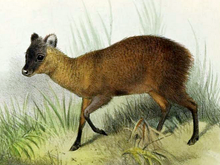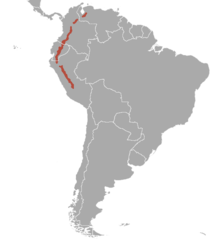| Northern pudu | |
|---|---|

| |
| Northern pudu (P. mephistophiles) | |
| Scientific classification | |
| Domain: | Eukaryota |
| Kingdom: | Animalia |
| Phylum: | Chordata |
| Class: | Mammalia |
| Order: | Artiodactyla |
| Family: | Cervidae |
| Subfamily: | Capreolinae |
| Genus: | Pudella |
| Species: | P. mephistophiles
|
| Binomial name | |
| Pudella mephistophiles (de Winton, 1896)
| |

| |
| Geographic range of Pudu mephistophiles | |
| Synonyms | |
|
Pudua mephistophiles de Winton, 1896[3] | |
The northern pudu (Pudella mephistophiles, Mapudungun püdü or püdu,[4] Spanish: pudú, Spanish pronunciation: [puˈðu]) is a species of South American deer native to the Andes of Colombia, Venezuela, Peru and Ecuador. It is the world's smallest deer[5] and is classified as Data Deficient in the IUCN Red List.[1] Originally classified under genus Pudu, some authorities consider it to belong to a separate genus (Pudella) from the southern pudu, along with Pudella carlae.[6]
YouTube Encyclopedic
-
1/3Views:19 6781 11313 402
-
Pudu facts: the Smallest Deer | Animal Fact Files
-
Pudu || Description and Facts!
-
ПУДУ: Самый маленький и редкий в мире олень | Интересные факты про оленей и животных
Transcription
Description
The northern pudu is the smallest species of deer in the world, standing 32 to 35 cm (13 to 14 in) tall at the shoulder and weighing 3.3 to 6 kg (7.3 to 13.2 lb).[7] The antlers of the northern pudu grow to about 6 cm (2.4 in) long and curve backward. Its coat tends to be lighter than that of the southern pudu, but the face is darker compared to the coat.[7]
Range and habitat
The northern pudu is found at higher altitudes than its sister species, from 2,000 to 4,000 m (6,600 to 13,100 ft) above sea level. It has a discontinuous range across the Andes of Colombia, Ecuador, and Peru. It inhabits montane forests, high-elevation elfin forests, and humid alpine páramo grasslands above the tree-line. The Marañón dry forests are a gap in the species' range, separating the Ecuadorian population from the Peruvian population in the Peruvian Yungas south of the Marañón River.[1]
References
- ^ a b c Barrio, J.; Tirira, D.G. (2019). "Pudu mephistophiles". IUCN Red List of Threatened Species. 2019: e.T18847A22163836. doi:10.2305/IUCN.UK.2019-1.RLTS.T18847A22163836.en. Retrieved 12 November 2021.
- ^ "Appendices | CITES". cites.org. Retrieved 14 January 2022.
- ^ de Winton, W. E. (1896). "On some Mammals from Ecuador". Proceedings of the Zoological Society of London. 64 (2): 507–513 [508]. doi:10.1111/j.1096-3642.1896.tb03055.x.
- ^ Muñoz Urrutia, Rafael, ed. (2006). Diccionario Mapuche: Mapudungun/Español, Español/Mapudungun (in Spanish) (2nd ed.). Santiago, Chile: Editorial Centro Gráfico Ltda. p. 184. ISBN 956-8287-99-X.
- ^ "Southern Pudu". Animal Planet. 2009. Archived from the original on 28 November 2012. Retrieved 19 September 2009.
- ^ Javier Barrio; Eliécer E Gutiérrez; Guillermo D’Elía (2024). "The First living cervid Species described in the 21st Century and Revalidation of Pudella (Artiodactyla)". Journal of Mammalogy. doi:10.1093/jmammal/gyae012.
- ^ a b Geist, Valerius (September 1998). Deer of the World: Their Evolution, Behaviour, and Ecology. Stackpole Books. pp. 119–121. ISBN 978-0-8117-0496-0.

